Deck 22: A New Deal for America: the Great Depression, 1929-1940
Question
Question
Question
Question
Question
Question
Question
Question
Question
Question
Question
Question
Question
Question
Question
Question
Question
Question
Question
Question
Question
Question
Question
Question
Question
Question
Question
Question
Question
Question
Question
Question
Question
Question
Question
Question
Question
Question
Question
Question
Question
Question
Question
Question
Question
Question
Question
Question
Question
Question

Unlock Deck
Sign up to unlock the cards in this deck!
Unlock Deck
Unlock Deck
1/50
Play
Full screen (f)
Deck 22: A New Deal for America: the Great Depression, 1929-1940
1
What was President Roosevelt referring to when he stated that "capitalism was saved in [those] eight days"?
A) The bank holiday that he imposed upon entering office
B) The amount of time it took to pass the Social Security Act
C) The creation of the National Recovery Administration that suspended antitrust laws
D) The appointment of his cabinet and the Brain Trust who advised him on financial issues
A) The bank holiday that he imposed upon entering office
B) The amount of time it took to pass the Social Security Act
C) The creation of the National Recovery Administration that suspended antitrust laws
D) The appointment of his cabinet and the Brain Trust who advised him on financial issues
The bank holiday that he imposed upon entering office
2
Although he shared a view with Progressive reformers about business having a responsibility to serve the community, how did President Herbert Hoover differ from these reformers?
A) He felt that government should provide federal assistance to support the poor.
B) He did not believe that government regulation should be used to solve economic problems.
C) He did not think voluntary and cooperative approaches between government and business could solve economic problems.
D) He thought it would be beneficial to pass more laws to assist the poor.
A) He felt that government should provide federal assistance to support the poor.
B) He did not believe that government regulation should be used to solve economic problems.
C) He did not think voluntary and cooperative approaches between government and business could solve economic problems.
D) He thought it would be beneficial to pass more laws to assist the poor.
He did not believe that government regulation should be used to solve economic problems.
3
Why did photographers Walker Evans and Dorothea Lange primarily choose to portray Alabama farmer Floyd Burroughs and "Migrant Mother" Florence Thompson in such serious poses?
A) The photographers wanted to document how hard their subjects worked in order to support their families despite their poverty during the Great Depression.
B) The solitary poses depicted their individualism that proved they were too proud to rely on federal aid.
C) Their seriousness was meant to convey their hostility to the upper class that put them in this situation.
D) They were depicted as neither smiling nor being angry to prove they were not responsible for their poverty and misery.
A) The photographers wanted to document how hard their subjects worked in order to support their families despite their poverty during the Great Depression.
B) The solitary poses depicted their individualism that proved they were too proud to rely on federal aid.
C) Their seriousness was meant to convey their hostility to the upper class that put them in this situation.
D) They were depicted as neither smiling nor being angry to prove they were not responsible for their poverty and misery.
They were depicted as neither smiling nor being angry to prove they were not responsible for their poverty and misery.
4
Under the Agricultural Marketing Act of 1929, the newly-established Farm Board helped American farmers by .
A) buying and storing surplus crops during gluts in order to lower crop prices
B) assisting them with funds needed to transport crops by railroad
C) providing access to credit to expand crop production
D) setting high prices on corn and wheat so that farmers could earn higher profits
A) buying and storing surplus crops during gluts in order to lower crop prices
B) assisting them with funds needed to transport crops by railroad
C) providing access to credit to expand crop production
D) setting high prices on corn and wheat so that farmers could earn higher profits

Unlock Deck
Unlock for access to all 50 flashcards in this deck.
Unlock Deck
k this deck
5
What were the Bonus Marchers demanding through their demonstrations in Washington, D.C., during the summer of 1932?
A) direct relief for workers from the federal government
B) employment for out-of-work veterans
C) early payment on federal bonds set to mature in 1945
D) an end to the Hoover presidency
A) direct relief for workers from the federal government
B) employment for out-of-work veterans
C) early payment on federal bonds set to mature in 1945
D) an end to the Hoover presidency

Unlock Deck
Unlock for access to all 50 flashcards in this deck.
Unlock Deck
k this deck
6
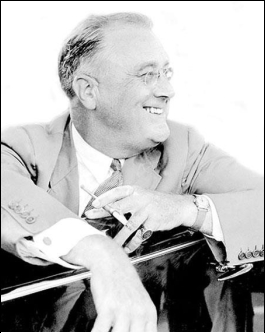
Why did photographs like this one showing Franklin D. Roosevelt with his trademark smile and cigarette holder make him so popular with the American public?
A) The public was enthralled that a wealthy aristocrat could connect with common people in a time of crisis.
B) The public found his visible cheerfulness reassuring, and this inspired confidence in America's future.
C) The public understood that his physical handicap meant he knew what it was like to be handicapped by poverty.
D) The public could connect with someone who smoked in public since that was a popular trend during the 1930s.

Unlock Deck
Unlock for access to all 50 flashcards in this deck.
Unlock Deck
k this deck
7
In the 1932 presidential election, Franklin D. Roosevelt campaigned as a .
A) Progressive-era regulator
B) conservative who would balance the budget
C) pragmatist who would experiment to get the economy going
D) revolutionary who would transform the role of government
A) Progressive-era regulator
B) conservative who would balance the budget
C) pragmatist who would experiment to get the economy going
D) revolutionary who would transform the role of government

Unlock Deck
Unlock for access to all 50 flashcards in this deck.
Unlock Deck
k this deck
8
Frances Perkins is noted as the first woman to have served as a(n) .
A) ambassador abroad
B) judge on the Court of Appeals
C) member of Congress
D) member of a president's cabinet
A) ambassador abroad
B) judge on the Court of Appeals
C) member of Congress
D) member of a president's cabinet

Unlock Deck
Unlock for access to all 50 flashcards in this deck.
Unlock Deck
k this deck
9
How did General Douglas MacArthur's response to the Bonus Marchers affect the view of the electorate toward President Hoover?
A) MacArthur's failure in his mission led the public to believe that Hoover lacked good judgment in his appointments to top positions.
B) MacArthur's insubordination led many to conclude that Hoover was an ineffective leader.
C) The harsh treatment of the veterans confirmed public opinion that Hoover was out of touch with the plight of ordinary Americans.
D) Most Americans admired the firm stance Hoover took against the demands of the Bonus Marchers.
A) MacArthur's failure in his mission led the public to believe that Hoover lacked good judgment in his appointments to top positions.
B) MacArthur's insubordination led many to conclude that Hoover was an ineffective leader.
C) The harsh treatment of the veterans confirmed public opinion that Hoover was out of touch with the plight of ordinary Americans.
D) Most Americans admired the firm stance Hoover took against the demands of the Bonus Marchers.

Unlock Deck
Unlock for access to all 50 flashcards in this deck.
Unlock Deck
k this deck
10
President Hoover provided direct financial support to banks, insurance companies, farm mortgage associations, and railroads through the establishment of the .
A) Reconstruction Finance Corporation
B) Emergency Relief Act
C) National Industrial Recovery Act
D) Works Progress Administration
A) Reconstruction Finance Corporation
B) Emergency Relief Act
C) National Industrial Recovery Act
D) Works Progress Administration

Unlock Deck
Unlock for access to all 50 flashcards in this deck.
Unlock Deck
k this deck
11
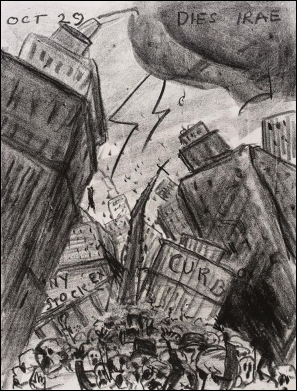
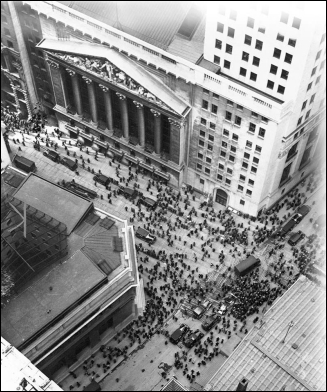
What do James Rosenberg's etching Oct. 29 Dies Irae (Day of Wrath) 1929 and the photograph taken on Wall Street that day convey about Black Tuesday?
A) Both images reflect the hardships that the stock market had on rural Americans.
B) Both images show that investors leapt to their deaths from city skyscrapers after the crash.
C) Both images capture the frenzied panic that swept Wall Street after the stock market crash.
D) Both images indicate that the United States was merely facing a minor economic recession.

Unlock Deck
Unlock for access to all 50 flashcards in this deck.
Unlock Deck
k this deck
12
Why did the Washington Star think it was newsworthy to print the 1935 headline "Mrs. Roosevelt Spends the Night at the White House"?
A) Eleanor Roosevelt traveled extensively as her husband's "eyes and ears" to report about conditions during the Great Depression
B) Franklin and Eleanor Roosevelt had a strained marriage and frequently lived apart from each other.
C) Eleanor Roosevelt preferred living at her husband's estate in Hyde Park, New York.
D) Eleanor Roosevelt believed the role of first lady should be unassuming and therefore felt it was unnecessary to live in the White House full time.
A) Eleanor Roosevelt traveled extensively as her husband's "eyes and ears" to report about conditions during the Great Depression
B) Franklin and Eleanor Roosevelt had a strained marriage and frequently lived apart from each other.
C) Eleanor Roosevelt preferred living at her husband's estate in Hyde Park, New York.
D) Eleanor Roosevelt believed the role of first lady should be unassuming and therefore felt it was unnecessary to live in the White House full time.

Unlock Deck
Unlock for access to all 50 flashcards in this deck.
Unlock Deck
k this deck
13
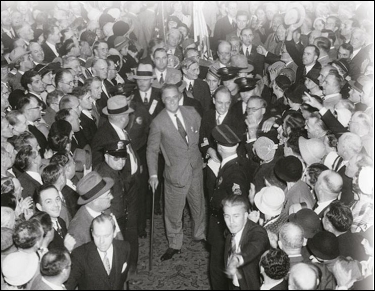
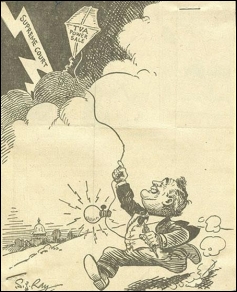
As shown in both the photograph of Franklin D. Roosevelt taken during the 1932 presidential campaign and the 1936 political cartoon from the Kansas City Star depicting a sprinting Roosevelt, why did FDR impose self-censorship on being photographed or depicted in his wheelchair?
A) He was in denial of the effect that polio had taken on his life.
B) He feared being viewed as weak and physically unfit to run the country.
C) He believed that the sight of his wheelchair would lower morale.
D) He did not want to inspire feelings of pity and sympathy in others.

Unlock Deck
Unlock for access to all 50 flashcards in this deck.
Unlock Deck
k this deck
14
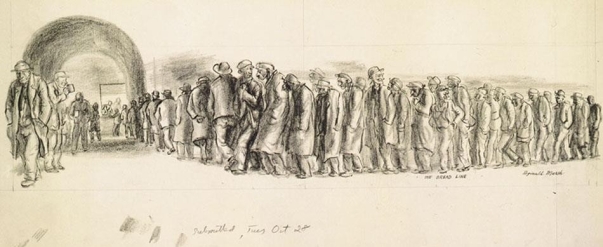
How did Reginald Marsh's sketch Bread Line respond to Hoover's statement that "no one is actually starving"?
A) The men are waiting in line to receive food; the drawing celebrates Hoover's leadership.
B) The men are gaunt, isolated, and clearly suffering; Hoover's statement is ironic.
C) The men are portrayed without their families, which were likely going hungry; this omission was a form of propaganda.
D) The men are banding together to start a riot; the drawing expresses rage at Hoover's indifference.

Unlock Deck
Unlock for access to all 50 flashcards in this deck.
Unlock Deck
k this deck
15
What measures made by President Hoover that addressed the federal response to the Great Depression were still acceptable to fiscal conservatives?
A) direct distribution of food and clothes to the poor
B) hiring for long-planned construction projects and imposing high protective tariffs
C) increasing wages and reducing the hours of the workday for laborers
D) organizing massive international relief forces to assist all areas of the world
A) direct distribution of food and clothes to the poor
B) hiring for long-planned construction projects and imposing high protective tariffs
C) increasing wages and reducing the hours of the workday for laborers
D) organizing massive international relief forces to assist all areas of the world

Unlock Deck
Unlock for access to all 50 flashcards in this deck.
Unlock Deck
k this deck
16
Why did overproduction of crops that largely resulted from mechanized agriculture hurt farmers economically during the 1920s?
A) The ability to grow more crops drove prices down.
B) Mechanized agriculture eliminated jobs for many farm laborers and sharecroppers.
C) Foreign countries placed high tariffs on imported American agricultural products.
D) More farming led to soil exhaustion which produced the massive dust storms that destroyed crops.
A) The ability to grow more crops drove prices down.
B) Mechanized agriculture eliminated jobs for many farm laborers and sharecroppers.
C) Foreign countries placed high tariffs on imported American agricultural products.
D) More farming led to soil exhaustion which produced the massive dust storms that destroyed crops.

Unlock Deck
Unlock for access to all 50 flashcards in this deck.
Unlock Deck
k this deck
17
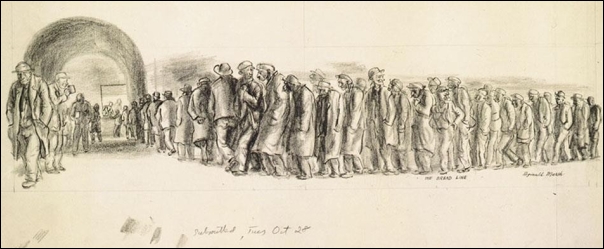
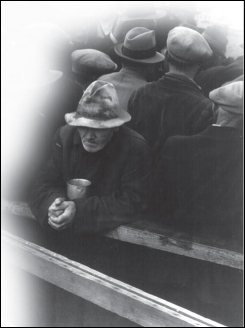
How does the image of poverty in Dorothea Lange's photograph "Breadline" San Francisco, 1933, compare with that in Reginald Marsh's drawing Bread Line?
A) Only Marsh's drawing portrays the impulse toward collective action.
B) Both portray the anger of the poor.
C) Only Lange's photograph portrays true hunger.
D) Both portray the isolation of the poor.

Unlock Deck
Unlock for access to all 50 flashcards in this deck.
Unlock Deck
k this deck
18
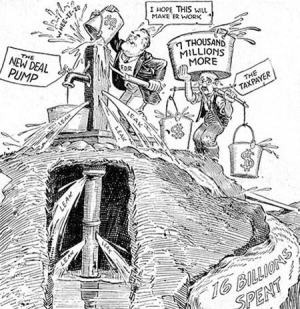
This cartoon reflecting Roosevelt's goal of government spending to fund the New Deal was created by .
A) liberals who favored using government funding to assist those affected by the Great Depression
B) Progressives who supported direct government financing of economic recovery programs
C) FDR's Brain Trust who wanted to use government regulation to solve economic issues
D) conservatives who felt that the president created expensive programs that did not work

Unlock Deck
Unlock for access to all 50 flashcards in this deck.
Unlock Deck
k this deck
19
What did federal investigator Lorena Hickok fear would happen to people who were not waiting patiently for improvements during the Great Depression when she stated that "I still feel that vast numbers of unemployed…are 'right on the edge' so to speak…"?
A) They would be instrumental in overthrowing the federal government.
B) They would be homeless and live on the streets.
C) They would join the Communist Party.
D) They would resort to committing crimes that would overflow jails.
A) They would be instrumental in overthrowing the federal government.
B) They would be homeless and live on the streets.
C) They would join the Communist Party.
D) They would resort to committing crimes that would overflow jails.

Unlock Deck
Unlock for access to all 50 flashcards in this deck.
Unlock Deck
k this deck
20
What was the chief cause of the stock market crash of 1929?
A) high tariffs
B) rising unemployment
C) declining farm prices
D) speculation in the stock market
A) high tariffs
B) rising unemployment
C) declining farm prices
D) speculation in the stock market

Unlock Deck
Unlock for access to all 50 flashcards in this deck.
Unlock Deck
k this deck
21
What resulted from the work of the Federal Housing Authority (FHA), which was established in 1934?
A) Home ownership increased dramatically.
B) The life of the typical mortgage was reduced.
C) A boom in the construction of new homes began.
D) The federal government took over home foreclosures.
A) Home ownership increased dramatically.
B) The life of the typical mortgage was reduced.
C) A boom in the construction of new homes began.
D) The federal government took over home foreclosures.

Unlock Deck
Unlock for access to all 50 flashcards in this deck.
Unlock Deck
k this deck
22
Why did the federal government beginning in 1929 effectively end legal immigration from Mexico for the duration of the Great Depression?
A) Job opportunities were better in Mexico.
B) The government wanted to protect the jobs of native-born Americans.
C) Violence between Mexican immigrants and "Okies" was on the rise.
D) Most Mexican immigrants were in the country illegally.
A) Job opportunities were better in Mexico.
B) The government wanted to protect the jobs of native-born Americans.
C) Violence between Mexican immigrants and "Okies" was on the rise.
D) Most Mexican immigrants were in the country illegally.

Unlock Deck
Unlock for access to all 50 flashcards in this deck.
Unlock Deck
k this deck
23

A migrant family such as the one pictured in this Dorothea Lange photograph was most likely headed _.
A) to the orange groves of Florida
B) to the factories of the Midwest or East
C) toward farms as far west as California
D) across the border to Mexico

Unlock Deck
Unlock for access to all 50 flashcards in this deck.
Unlock Deck
k this deck
24
The Civilian Conservation Corps (CCC) was organized in order to .
A) train farmers in advanced agricultural methods
B) administer direct relief to the unemployed
C) subsidize the creation of public art
D) provide work experience for disadvantaged young men
A) train farmers in advanced agricultural methods
B) administer direct relief to the unemployed
C) subsidize the creation of public art
D) provide work experience for disadvantaged young men

Unlock Deck
Unlock for access to all 50 flashcards in this deck.
Unlock Deck
k this deck
25
How did the Indian Reorganization Act set the stage for a rebirth of Native American culture?
A) It expanded the land allotment policies of the 1887 Dawes Act.
B) It unified all First Nations under the authority of Commissioner John Collier.
C) It established limited self-government on Indian reservations.
D) It formed the first Indian reservations.
A) It expanded the land allotment policies of the 1887 Dawes Act.
B) It unified all First Nations under the authority of Commissioner John Collier.
C) It established limited self-government on Indian reservations.
D) It formed the first Indian reservations.

Unlock Deck
Unlock for access to all 50 flashcards in this deck.
Unlock Deck
k this deck
26
How did Roosevelt's efforts to address unemployment compare with those of Hoover?
A) Unlike Hoover, Roosevelt ultimately put people to work directly for the government.
B) Unlike Hoover, Roosevelt preferred to give financial assistance to the unemployed.
C) Both presidents relied on the ingenuity of businesses to address the crisis.
D) Unlike Roosevelt, Hoover did nothing to address unemployment, even indirectly.
A) Unlike Hoover, Roosevelt ultimately put people to work directly for the government.
B) Unlike Hoover, Roosevelt preferred to give financial assistance to the unemployed.
C) Both presidents relied on the ingenuity of businesses to address the crisis.
D) Unlike Roosevelt, Hoover did nothing to address unemployment, even indirectly.

Unlock Deck
Unlock for access to all 50 flashcards in this deck.
Unlock Deck
k this deck
27
How did the Tennessee Valley Authority (TVA) impact rural farmers living in the South?
A) The TVA assisted with the planting of 220 million trees to reduce dust storms.
B) Sharecroppers found assistance to break out of the traditional cycle of debt that bound them to landowners.
C) The dams constructed through this agency brought electricity to rural areas.
D) Assistance in removing land from cultivation led to a doubling of farm income during the Great Depression.
A) The TVA assisted with the planting of 220 million trees to reduce dust storms.
B) Sharecroppers found assistance to break out of the traditional cycle of debt that bound them to landowners.
C) The dams constructed through this agency brought electricity to rural areas.
D) Assistance in removing land from cultivation led to a doubling of farm income during the Great Depression.

Unlock Deck
Unlock for access to all 50 flashcards in this deck.
Unlock Deck
k this deck
28

What controversial topic did William Gropper's "Automobile Industry" mural in a Detroit post office, which glorified autoworkers and was a part of the Treasury Department's project to put artists to work during the Great Depression, leave out?
A) the deadening routine of the assembly line and the numerous strikes in this industry
B) the poverty resulting from Henry Ford's refusal to implement higher wages
C) the charity given by the states to autoworkers during the Great Depression
D) the laziness characteristic of WPA workers who did nothing and wasted time

Unlock Deck
Unlock for access to all 50 flashcards in this deck.
Unlock Deck
k this deck
29
Which New Deal work relief program, which eventually employed one-fifth of the workforce during the Great Depression, was an unemployed worker referring to when he said that "I gave the best part of my life to the American country, and I spent every cent I made here. They owe it to me to take care of me"?
A) the Civil Works Administration (CWA)
B) the Public Works Administration (PWA)
C) the Works Progress Administration (WPA)
D) the Civilian Conservation Corps (CCC)
A) the Civil Works Administration (CWA)
B) the Public Works Administration (PWA)
C) the Works Progress Administration (WPA)
D) the Civilian Conservation Corps (CCC)

Unlock Deck
Unlock for access to all 50 flashcards in this deck.
Unlock Deck
k this deck
30
What was an early reason for Charles Coughlin's initial support of the New Deal and President Roosevelt before he became critical of both?
A) Roosevelt suppressed the challenges made by Communists to the New Deal.
B) Roosevelt closed the banks until legislation could be passed to reform banking.
C) Roosevelt supported the repeal of prohibition.
D) Roosevelt took the nation off the gold standard.
A) Roosevelt suppressed the challenges made by Communists to the New Deal.
B) Roosevelt closed the banks until legislation could be passed to reform banking.
C) Roosevelt supported the repeal of prohibition.
D) Roosevelt took the nation off the gold standard.

Unlock Deck
Unlock for access to all 50 flashcards in this deck.
Unlock Deck
k this deck
31
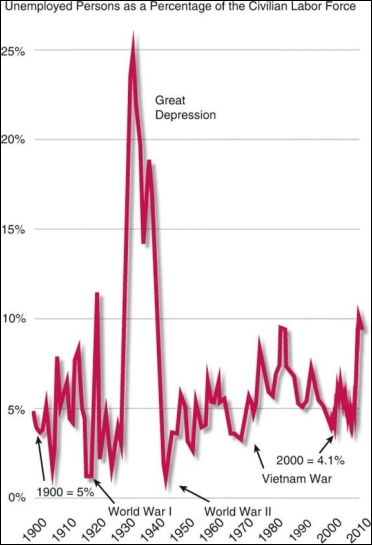
Besides the fact that the Great Depression showed the highest unemployment rate of the twentieth century, what other generalization regarding unemployment can be made from interpreting the graph above?
A) Unemployment has been a relatively minor issue in the twenty-first century.
B) Unemployment has generally been lower during times of war.
C) Unemployment continued to drop after the conclusion of a war.
D) Unemployment was higher at the beginning of the twentieth century than it was at the beginning of the twenty-first century.

Unlock Deck
Unlock for access to all 50 flashcards in this deck.
Unlock Deck
k this deck
32
What program developed by Louisiana Senator Huey Long was he describing when he stated that "…we propose that no family will have an earning of less than around $2,000 to $2,500 and that none will have more than three hundred times the average less the ordinary income taxes…"?
A) Share Our Wealth
B) Social Security
C) the National Recovery Administration
D) the Works Progress Administration
A) Share Our Wealth
B) Social Security
C) the National Recovery Administration
D) the Works Progress Administration

Unlock Deck
Unlock for access to all 50 flashcards in this deck.
Unlock Deck
k this deck
33
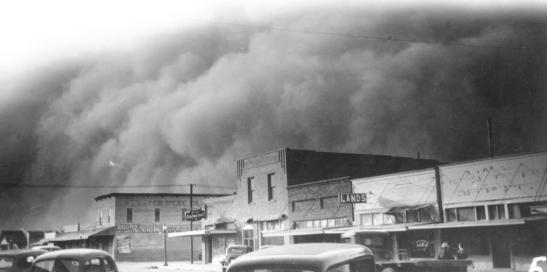
Dust storms such as this one descending on a small town in Kansas resulted from
A) farmers taking land out of cultivation so they could receive federal aid
B) drought and soil erosion
C) planting crops like legumes rather than cash crops like wheat, cotton, and tobacco
D) an overabundance of trees on the Great Plains that hampered the flow of the wind

Unlock Deck
Unlock for access to all 50 flashcards in this deck.
Unlock Deck
k this deck
34
What group is described as "riding the rails" by hopping into freight cars during the Depression?
A) Native Americans who left their reservations and took to the open road
B) Oklahoma families who lost their farms in the Dust Bowl
C) immigrants who worked on the railroad
D) teenagers who hopped onto empty freight cars
A) Native Americans who left their reservations and took to the open road
B) Oklahoma families who lost their farms in the Dust Bowl
C) immigrants who worked on the railroad
D) teenagers who hopped onto empty freight cars

Unlock Deck
Unlock for access to all 50 flashcards in this deck.
Unlock Deck
k this deck
35
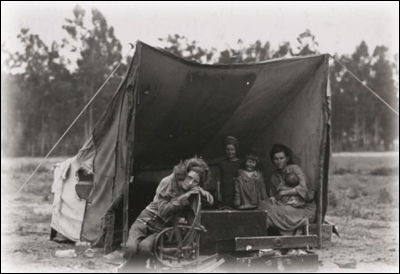
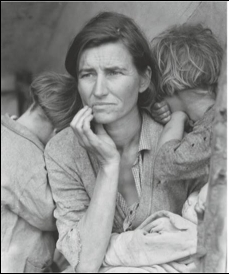
Why did photographer Dorothea Lange believe that the picture on the right, "Migrant Mother series no. 6," would have a more powerful impact on the public than the initial picture on the left, "Migrant Mother series no. 2"?
A) "Series no. 6" demonstrated that, by showing trash in their living quarters, the family was undisciplined and lazy.
B) "Series no. 6" depicted a family who was asking the government to provide federal support.
C) "Series no. 6" sent a clearer message that focused on the despair of the mother and her small children.
D) "Series no. 6" showed that the mother began to have children at a very young age.

Unlock Deck
Unlock for access to all 50 flashcards in this deck.
Unlock Deck
k this deck
36
What did the Glass-Steagall Act of 1933 do to boost American confidence in the banking system?
A) It established closer ties between investment and commercial banking.
B) It instituted regular bank holidays.
C) It created the FDIC to insure bank deposits.
D) It provided insurance to banks in the event of another stock market crash.
A) It established closer ties between investment and commercial banking.
B) It instituted regular bank holidays.
C) It created the FDIC to insure bank deposits.
D) It provided insurance to banks in the event of another stock market crash.

Unlock Deck
Unlock for access to all 50 flashcards in this deck.
Unlock Deck
k this deck
37
How did the Agricultural Adjustment Act (AAA) attempt to raise crop prices and relieve farmers?
A) by providing tax relief for the poor
B) by increasing the amount of crops in circulation
C) by employing immigrant labor
D) by paying farmers to take land out of cultivation
A) by providing tax relief for the poor
B) by increasing the amount of crops in circulation
C) by employing immigrant labor
D) by paying farmers to take land out of cultivation

Unlock Deck
Unlock for access to all 50 flashcards in this deck.
Unlock Deck
k this deck
38
How did Father Charles Coughlin influence FDR's first administration?
A) His plan to seize funds from the rich for distribution amongst the poor indirectly inspired many New Deal policies.
B) His criticisms of FDR's policies roused the public and cornered FDR into providing direct aid to the unemployed.
C) Popular support for his attacks on financiers and bankers pushed FDR to the left.
D) He encouraged FDR to place bankers in charge of government departments that handled economic affairs.
A) His plan to seize funds from the rich for distribution amongst the poor indirectly inspired many New Deal policies.
B) His criticisms of FDR's policies roused the public and cornered FDR into providing direct aid to the unemployed.
C) Popular support for his attacks on financiers and bankers pushed FDR to the left.
D) He encouraged FDR to place bankers in charge of government departments that handled economic affairs.

Unlock Deck
Unlock for access to all 50 flashcards in this deck.
Unlock Deck
k this deck
39
Dorothea Lange's photographs for the Resettlement Administration were intended to
A) stir public empathy for migrant farmers
B) arouse popular anger about the unfair treatment of laborers
C) encourage Congress to pass more effective legislation to support migrant laborers
D) condemn Californians for discriminating against "Okies"
A) stir public empathy for migrant farmers
B) arouse popular anger about the unfair treatment of laborers
C) encourage Congress to pass more effective legislation to support migrant laborers
D) condemn Californians for discriminating against "Okies"

Unlock Deck
Unlock for access to all 50 flashcards in this deck.
Unlock Deck
k this deck
40
The Securities and Exchange Commission (SEC) was created to regulate .
A) international trade
B) the stock market
C) banks
D) the availability of credit
A) international trade
B) the stock market
C) banks
D) the availability of credit

Unlock Deck
Unlock for access to all 50 flashcards in this deck.
Unlock Deck
k this deck
41
In the 1930s, black voters abandoned the Republicans for the Democratic Party. What does this shift in allegiance reveal about the FDR's Democratic Party?
A) It was firm and open in its commitment to civil rights.
B) It was believed to be a champion of those who had less power in society.
C) Its policies addressed all the needs of African Americans.
D) It had finally apologized for the legacy of African-American enslavement.
A) It was firm and open in its commitment to civil rights.
B) It was believed to be a champion of those who had less power in society.
C) Its policies addressed all the needs of African Americans.
D) It had finally apologized for the legacy of African-American enslavement.

Unlock Deck
Unlock for access to all 50 flashcards in this deck.
Unlock Deck
k this deck
42
How did Franklin Roosevelt react to business leaders' hostility to New Deal programs?
A) He met with them but ultimately rejected their arguments.
B) He attempted to appeal to them based on his own privileged background.
C) He proposed tax cuts for the rich.
D) He aligned himself with labor.
A) He met with them but ultimately rejected their arguments.
B) He attempted to appeal to them based on his own privileged background.
C) He proposed tax cuts for the rich.
D) He aligned himself with labor.

Unlock Deck
Unlock for access to all 50 flashcards in this deck.
Unlock Deck
k this deck
43
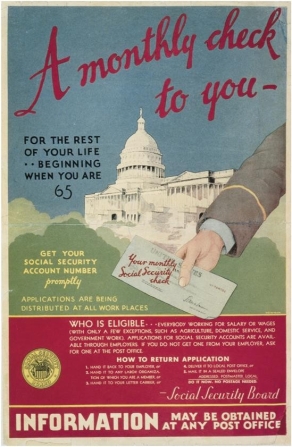
What important piece of information related to Social Security has been omitted from this poster?
A) emphasizing that the checks will be coming from the government
B) encouraging eligible workers to apply
C) pointing out that payroll taxes will fund the program
D) explaining how to apply

Unlock Deck
Unlock for access to all 50 flashcards in this deck.
Unlock Deck
k this deck
44
What was the effect of President Roosevelt's "Court-packing scheme"?
A) Roosevelt alienated Republicans who previously supported his legislation.
B) Roosevelt was able to appoint seven judges to the Supreme Court.
C) Several Supreme Court justices resigned in protest.
D) The Supreme Court ended the New Deal by ruling that the legislation was unconstitutional.
A) Roosevelt alienated Republicans who previously supported his legislation.
B) Roosevelt was able to appoint seven judges to the Supreme Court.
C) Several Supreme Court justices resigned in protest.
D) The Supreme Court ended the New Deal by ruling that the legislation was unconstitutional.

Unlock Deck
Unlock for access to all 50 flashcards in this deck.
Unlock Deck
k this deck
45
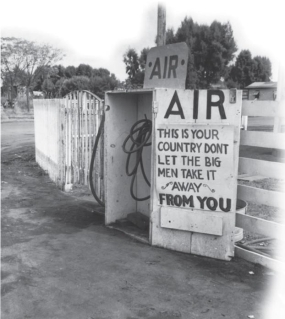
What message did signs such as this photograph taken by Dorothea Lange convey to the average American?
A) a general animosity toward the wealthy
B) dissatisfaction with the government
C) a need for lower taxes
D) the beginnings of social reform

Unlock Deck
Unlock for access to all 50 flashcards in this deck.
Unlock Deck
k this deck
46

What is implied by this 1937 photo shot by Margaret Bourke-White in Louisville, Kentucky?
A) "The world's highest standard of living" was available to all Americans.
B) "The American Way" involved excluding some groups from prosperity.
C) Owning an automobile was the greatest hope of many African Americans.
D) It was not necessary for the New Deal to address the specific needs of African Americans.

Unlock Deck
Unlock for access to all 50 flashcards in this deck.
Unlock Deck
k this deck
47
Who was the California doctor responsible for organizing a campaign for old-age pensions that later became the foundation for the Social Security Act of 1935?
A) Huey Long
B) Francis Townshend
C) Ida May Fuller
D) John L. Lewis
A) Huey Long
B) Francis Townshend
C) Ida May Fuller
D) John L. Lewis

Unlock Deck
Unlock for access to all 50 flashcards in this deck.
Unlock Deck
k this deck
48
Declaring that workers had the right to organize and bargain collectively, the became known as the "Magna Carta" of organized labor because it recognized a right many industrialists still refused to acknowledge.
A) Wagner Act
B) National Industrial Recovery Act
C) Fair Labor Standards Act
D) Social Security Act
A) Wagner Act
B) National Industrial Recovery Act
C) Fair Labor Standards Act
D) Social Security Act

Unlock Deck
Unlock for access to all 50 flashcards in this deck.
Unlock Deck
k this deck
49
How did the Congress of Industrial Organizations (CIO) differ from its rival union, the American Federation of Labor (AFL)?
A) It excluded unskilled workers from union membership.
B) It excluded African Americans from union membership.
C) It accepted women into their union with full support.
D) It organized workers by an entire industry rather than by their trade orientation.
A) It excluded unskilled workers from union membership.
B) It excluded African Americans from union membership.
C) It accepted women into their union with full support.
D) It organized workers by an entire industry rather than by their trade orientation.

Unlock Deck
Unlock for access to all 50 flashcards in this deck.
Unlock Deck
k this deck
50
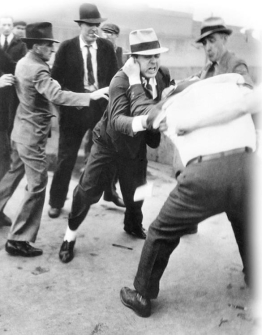
Why did photographs such as this one taken at the Ford motor plant in Dearborn, Michigan, cause a public outcry?
A) They revealed the rough tactics often employed by union organizers.
B) They showed how sit-down strikes often turned violent.
C) They showed the brutality of Ford security forces against union organizers.
D) They revealed the tensions between AFL and CIO members.

Unlock Deck
Unlock for access to all 50 flashcards in this deck.
Unlock Deck
k this deck



